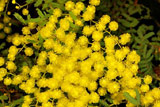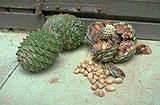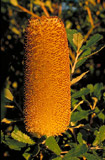|
[Front Page] [Features] [Departments] [SGAP Home Page] [Subscribe]

First Cuttings
Waiting for Wollemi
If you're one of the many people who would like a plant of Wollemia nobilis (the Wollemi Pine) you might have to wait longer than expected. It was originally anticipated that plants may become available to the general public during 1999 but a report in the Sydney Morning Herald (9 March 1999) suggests otherwise.
The NSW State Government has announced that a contract for the commercial development of the plant has been awarded to a Queensland nursery (Birkdale Nursery) in partnership with the Queensland Department of Primary Industries. The NSW Government will get a 10% royalty estimated to be worth about $100,000 per year.
The bottom line is that plants will probably start appearing in garden Centres in 2004-2005 at around $20 each.
In the meantime, if you want to see a specimen of W.nobilis actually growing in the ground, you will need to visit the Royal Botanic gardens in Sydney. There you can see the plant through the 2 metre high steel bars which have been placed around the plant to prevent theft and vandalism.

Olympic's Vandalism
While on the subject of vandalism........
Are you as fed up with the Olympic Games as I am? Apart from the sickening grovelling that goes on whenever someone from the IOC swans into town and the obscene amount of money that goes into trying to win "gold", this little item in the Sydney Morning Herald (March 17, 1999) caught my attention...."Council clears protected bushland for Olympic Games work".
It seems, if the report is correct, that contractors for Bankstown Council cleared bushland at Georges Hall in Sydney’s south-west to accommodate the Olympic Cycling Velodrome. "So what", some may ask. "It happens all the time". True. But in this case the bushland was Cumberland Plain Woodland, recently "protected" under the Threatened Species Conservation Act. It also contained Acacia pubescens, also "protected".
 |
Acacia pubescens....bulldozed in the name of Olympic "glory".
Select the thumbnail image or plant name for a higher resolution image (30k)
|
Of course there will be much consternation in Council and much wringing of hands....Conciliatory noises will be made and investigations will be held to ensure such a thing could never happen again. "We’ll landscape with native plants," they will say, and one wonders how many Cootamundra wattles or Queensland Silver wattles will be planted to replace the A.pubescens and pollute whatever bushland remains nearby.
What a lot of crap! In the end the Velodrome is built, Council has its way and another piece of western Sydney bushland disappears forever....Isn't the "Green Olympics" just wonderful!!

Edible Wattle Seeds....source found?
In the last issue I mentioned (from an unknown source) a new book published by the Department of Conservation and Land Management (Western Australia) and CSIRO Forestry and Forestry Products describing research into 18 of the most promising Acacia species for human consumption.
Paul Segal suggests that the source may have been a CSIRO media release and advises that the article can be found at:
http://www.csiro.au/news/mediarel/mr1998/mr98213.html
as well as details of the book itself.
Thanks Paul!

Watch your Head!!!
Another report from the Sydney Morning Herald (this time February 12, 1999).....
The report warns of the aerial bombardment being carried out by Bunya pines (Araucaria bidwillii) at NSW Forestry's Cumberland State Forest in north-west Sydney.
 
A combination of factors (heavy rains, an extended pine-growing season and "a genetic disposition to gigantism") resulted in the largest Bunya pine cones seen at the forest for 50 years. Some of the cones weighed in a 10 kilograms and, as they occur many metres above ground level and are shed unpredictably, it doesn't require a vivid imagination to picture the damage they could do if they plummeted onto an unsuspecting passer-by below! The article reports that in one day 37 of the cones were shed from the Forest's plantation.
Bunya pines are native to mountains in south-east and northern Queensland but are widely cultivated elsewhere. The nuts are edible and were a rich source of food for the Aborigines of south-east Queensland. The pines generally have their heaviest falls every three years. During the "Bunya season" the Aborigines would temporarily set aside their tribal differences and gather in the mountains for great Bunya Nut Feasts.
 |
The fruit of Araucaria bidwillii can be as large as a football.....but considerably heavier!.
Select the thumbnail image or plant name for a higher resolution image (37k). Photo: J.Sked
|

Horticultural Database for Western Flora
The Wildflower Society of Western Australia, Kings Park and Botanic Garden and the Western Australian Herbarium, sponsored by the Gordon Reid Foundation, have commenced a one-year pilot project to establish a database for the horticultural aspects of native flora, both wild and cultivated. Previous projects initiated by the Society have determined the botanical descriptions of taxa and this work is featured in Florabase (see "Net Watch" - December 1998). The current project seeks information on the propagation and cultural aspects of targeted species.
The Wildflower Society has engaged the services of Antony Konig who will be promoting the project to members. He has a background in horticulture and training and is working closely with staff in Kings Park who have developed the Horticultural Database.
Aims of the one-year pilot project (commenced in November 1998) are to:
- Establish a reliable and user friendly data collection and reporting package for interested parties to record horticultural information.
- Develop a training package to teach personnel to use input package.
- Target personnel from the Wildflower Society and other sources for horticultural information and train to use data input package.
- Promote the project.
- Collate and analyse information and prepare reports on results, performance and potential of database system relating to horticultural aspects of wild and cultivated plants, landcare issues, restoration ecology and promote the conservation and promotion of the Western Australian flora.
- Disseminate horticultural information collected during the pilot project.
To achieve the above aims, the focus will be on:
- Banksia spp.
 
Information from Kings Park staff has been initially collected to fine-tune the database software. Interested parties and banksia growers are now asked to contribute. This knowledge will be an integral part of a report in November 1999 and may provide the basis for a booklet on growing banksias. Assessing the time and resources required for banksias enables extrapolation and estimation for the resources required to complete the horticultural information on all Western Australian genera.
Select the thumbnail image for a higher resolution image (40k).
- Western Australian flora used in landcare restoration.
This study would seek to identify plants used in landcare restoration, detail horticultural information on species, contrast differences between field and garden grown species, identify gaps in knowledge and establish methods of reporting and accessing horticultural information relevant to landcare restoration. Two regions, or the most three, will be selected with resource estimation for future work being important. This information will form part of the final report and again may provide the basis for a booklet.
For further information on the project contact:
Antony Konig, Horticultural Database Consultant for the Wildflower Society
c/- Kings Park and Botanic Garden, West Perth 6005
Phone 08 9480 3653. Fax (08) 9480 3601; Email antonyk@kpbg.wa.gov.au

 | Contributions Welcome!
Contributions to Australian Plants online, no matter how small, are always welcome. Issues concerning Australian plants extracted from your local newspapers are particularly useful. As I'm based in New South Wales, I don't regularly see information like this beyond NSW borders. And I'd hate to be accused of being parochial!
Information that can't be emailed can be sent to me at 158 West Wilchard Rd, Castlereagh, NSW, 2749, Australia.
|
Good growing
Brian Walters

[Front Page] [Features] [Departments] [SGAP Home Page] [Subscribe]
Australian Plants online - March 1999
The Society for Growing Australian Plants
|